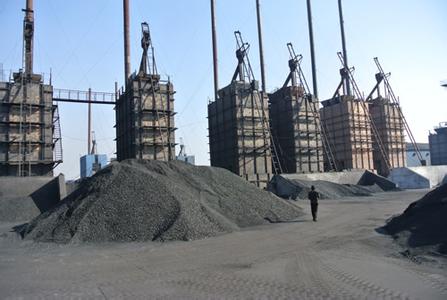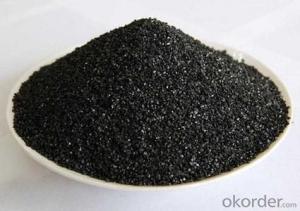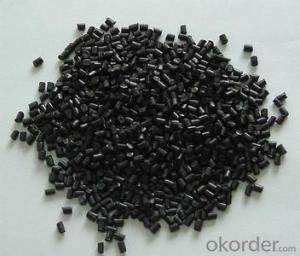Carbon Additive FC 97 for casting iron and steel plant foundry
- Loading Port:
- Qingdao
- Payment Terms:
- TT OR LC
- Min Order Qty:
- 10 m.t
- Supply Capability:
- 300000 m.t/month
OKorder Service Pledge
OKorder Financial Service
You Might Also Like
Specifications of carburant:
- Carburant for casting professional manufacturer in china 15 years experience;
- Carburant for casting specification as follows:
Item No (max) | Fixed Carbon | Sulfur(max) | Ash(max) | V.M | Moisture | Grain size(90%) | Nitrogen(max) |
CA-02 | 98.50% | 0.50% | 0.80% | 0.80% | 0.50% | 1-5MM | N/A |
CA-06 | 99.00% | 0.30% | 0.50% | 0.50% | 0.50% | 1-5MM | 1000divdivM |
CA-10 | 95.00% | 0.30% | 3.50% | 1.50% | 0.50% | 1-4MM | 700divdivM |
CA-12 | 80.00% | 0.10% | 16.50% | 3.50% | 2.00% | 1-5mm | N/A |
By using the carbon additive from CNBM in producing casting, it can increase the used quantity of Scrap steel and reduce the quantity of Scrap iron, or use no Scrap iron at all, CNBM carbon additive has follows properties: high absorptive character, no residue will be left, save production cost.
- Usage used to improve the Carbon content in steel-melting and Ductile iron foundry
- Characteristica high carbon, low sulfur, with stable effect for improving the carbon content, high absorptivity of carbon.
- Apply Used in electric furnace steel smelting and cast-iron for improving the carbon content
- Grain size normal size0.3-3mm 1-4mm1-3mm3-5mm,3-8mm,5-10mm or per as customers special requirement.

- Q:How does carbon contribute to the strength of concrete?
- Carbon contributes to the strength of concrete by reinforcing it through the formation of calcium silicate hydrate (C-S-H) gel. This gel fills in the gaps in the concrete matrix, enhancing its density and reducing porosity. Additionally, the carbonaceous material reacts with calcium hydroxide (a byproduct of cement hydration), producing calcium carbonate. The formation of calcium carbonate increases the overall strength and durability of the concrete structure.
- Q:What are the impacts of carbon emissions on the stability of polar ice caps?
- The stability of polar ice caps is significantly affected by carbon emissions, which arise primarily from the burning of fossil fuels. This process releases substantial amounts of carbon dioxide into the atmosphere, a greenhouse gas that traps heat and contributes to global warming and climate change. Consequently, the ice caps in the polar regions, which are extremely sensitive to temperature changes, experience accelerated melting as the Earth's temperature rises due to increased carbon emissions. This leads to a rise in sea levels, with far-reaching consequences for coastal regions globally, including increased flooding, erosion, and the loss of valuable coastal ecosystems. Furthermore, the preservation of the polar ice caps is vital for maintaining the Earth's climate balance. These ice caps play a crucial role in reflecting sunlight back into space, serving as a natural cooling mechanism for the planet. However, as they melt, less sunlight is reflected, resulting in more absorption by the Earth's surface and exacerbating the warming effect. This creates a feedback loop, where the melting of ice caps leads to further warming, causing more ice to melt. The impacts of carbon emissions on polar ice caps extend beyond rising sea levels and climate change. The loss of ice also disrupts the delicate balance of ecosystems in these regions. Polar ice caps provide habitat and sustenance for a diverse range of organisms, including polar bears, seals, and various species of birds. Consequently, the melting of ice disrupts these ecosystems, leading to declines in wildlife populations and potential extinctions. Moreover, the melting of polar ice caps also has repercussions for global ocean currents and weather patterns. The melting ice forms cold, dense water that sinks to the bottom of the ocean and drives crucial oceanic circulation patterns. Changes in these patterns can have far-reaching consequences, such as altering the distribution of marine species, impacting fisheries, and influencing regional climates. To mitigate the impacts of carbon emissions on polar ice caps, it is essential to reduce greenhouse gas emissions and transition to cleaner and renewable energy sources. International initiatives, such as the Paris Agreement, are aimed at limiting global warming and reducing carbon emissions to prevent further melting of the ice caps. Additionally, supporting research and monitoring programs in polar regions can enhance our understanding of these complex systems and facilitate the development of effective conservation strategies.
- Q:How is carbon used in the production of activated carbon filters?
- Various industries and applications widely utilize activated carbon filters. These filters are utilized in water and air purification, gas masks, and even in the production of certain chemicals. The effectiveness of activated carbon filters heavily relies on the role of carbon in their production. Activated carbon, also referred to as activated charcoal, is a type of carbon that possesses a highly porous structure and a large surface area. The creation of this porous structure is achieved through a process known as activation. Activation involves subjecting carbonaceous materials, such as coal, wood, or coconut shells, to high temperatures in the presence of steam or specific chemicals. This activation process generates tiny pores and significantly increases the carbon's surface area. Consequently, the carbon becomes adept at capturing and eliminating impurities from gases or liquids. The activated carbon's high adsorption capacity attracts impurities like organic compounds, volatile organic compounds (VOCs), and certain heavy metals to its surface. In the production of activated carbon filters, the activated carbon is commonly molded into a granular or powdered state and then packed into a filter medium, such as a mesh or a cartridge. The filter medium functions as a supportive structure for the activated carbon, enabling the passage of air or water while effectively capturing and adsorbing impurities. Activated carbon filters excel at eliminating a wide array of contaminants, including chlorine, volatile organic compounds (VOCs), odors, and specific heavy metals. Consequently, these filters greatly enhance the quality of water and air by reducing pollutants and improving odor control. Furthermore, the versatility of activated carbon allows for customization based on the specific application. For instance, activated carbon can be infused with specific chemicals to heighten its adsorption capacity for particular contaminants. It can also be specially treated to target pollutants like mercury or arsenic. In conclusion, the utilization of carbon in the production of activated carbon filters stems from its porous structure and exceptional adsorption properties. These filters play a vital role in numerous industries and applications, effectively eliminating impurities from water and air, improving their quality, and ultimately benefiting environmental and human health.
- Q:What are the different types of carbon-based polymers?
- There are several different types of carbon-based polymers, each with its own unique properties and applications. Some of the most common types include: 1. Polyethylene (PE): This is one of the most widely used polymers and is known for its high strength and chemical resistance. It is commonly used in packaging materials, plastic bottles, and pipes. 2. Polypropylene (PP): PP is similar to PE but with a higher melting point and better resistance to heat. It is commonly used in automotive parts, textiles, and food packaging. 3. Polystyrene (PS): PS is a lightweight and rigid polymer that is commonly used in packaging materials, disposable utensils, and insulation. 4. Polyvinyl chloride (PVC): PVC is a versatile polymer that can be rigid or flexible depending on the additives used. It is commonly used in pipes, electrical insulation, and flooring. 5. Polyethylene terephthalate (PET): PET is a strong and lightweight polymer that is commonly used in beverage bottles, food containers, and synthetic fibers. 6. Polyurethane (PU): PU is a flexible and durable polymer that is commonly used in foams, coatings, adhesives, and textiles. 7. Polycarbonate (PC): PC is a strong and transparent polymer that is commonly used in eyeglass lenses, safety goggles, and electronic components. 8. Phenolic resins: These polymers are known for their excellent heat resistance and are commonly used in coatings, adhesives, and electrical components. These are just a few examples of the many carbon-based polymers that exist. Each type has its own specific properties and applications, making them suitable for a wide range of industries and products.
- Q:How does carbon affect the formation of tornadoes?
- Carbon does not have a direct effect on tornado formation. Tornadoes primarily occur when warm, moist air from the surface interacts with cold, dry air from higher levels of the atmosphere, creating strong upward drafts and rotating air columns. Carbon, as an element, does not have a significant role in this process. However, carbon emissions and human-induced climate change can indirectly impact weather patterns, including the frequency and intensity of tornadoes. The burning of fossil fuels, which releases carbon dioxide into the atmosphere, contributes to global warming. This, in turn, leads to changes in temperature and moisture patterns that can influence the conditions necessary for tornado formation. The increased levels of carbon dioxide in the atmosphere can cause the atmosphere to become more unstable, creating conditions favorable for severe thunderstorms that can produce tornadoes. Moreover, the warmer atmosphere with higher moisture content can provide more fuel for these storms, potentially making them stronger. It is important to note that the relationship between carbon emissions and tornadoes is complex and still an ongoing area of research. While there is a possibility of a connection between climate change and tornadoes, it is difficult to attribute individual tornadoes solely to carbon emissions, as tornadoes are influenced by various meteorological factors. In conclusion, carbon does not directly impact tornado formation, but the increased carbon emissions and resulting climate change can indirectly affect the conditions that contribute to tornado formation. Further scientific research is necessary to fully comprehend the relationship between carbon emissions, climate change, and tornado activity.
- Q:What is the relationship between carbon emissions and air pollution?
- Carbon emissions and air pollution are closely interconnected. Carbon emissions, which mainly come from burning fossil fuels such as coal, oil, and natural gas, release large amounts of carbon dioxide (CO2) into the atmosphere. This increase in CO2 levels contributes significantly to the greenhouse effect, trapping heat in the atmosphere and leading to global warming. Air pollution, on the other hand, refers to the presence of harmful substances in the air that can be detrimental to human health and the environment. While carbon dioxide itself is not directly toxic to humans, it plays a crucial role in the formation of other air pollutants. One of the primary consequences of increased carbon emissions is the production of fine particulate matter (PM2.5) and ground-level ozone (O3). These pollutants are created through complex chemical reactions involving CO2 and other pollutants like nitrogen oxides (NOx) and volatile organic compounds (VOCs). PM2.5 and O3 are known to cause respiratory problems, cardiovascular diseases, and other health issues. Furthermore, carbon emissions also contribute to the formation of other air pollutants such as sulfur dioxide (SO2), nitrogen oxides (NOx), and heavy metals. These pollutants are emitted alongside CO2 from various industrial processes, power generation, and transportation. They can have severe health impacts, including respiratory diseases, asthma, and even cancer. Reducing carbon emissions is crucial to combatting air pollution. By transitioning to cleaner energy sources like renewables and improving energy efficiency, we can significantly reduce the amount of CO2 and other pollutants emitted into the atmosphere. Implementing stricter regulations and adopting cleaner technologies in industries and transportation can also help reduce air pollution and its associated health risks. In conclusion, carbon emissions and air pollution are intrinsically linked. The release of CO2 and other pollutants from burning fossil fuels contributes to global warming and the formation of harmful air pollutants. Addressing the problem of carbon emissions is essential to mitigate air pollution and protect human health and the environment.
- Q:What are the environmental impacts of carbon emissions?
- The environmental impacts of carbon emissions include climate change, air pollution, ocean acidification, and ecosystem disruptions. Carbon emissions contribute to the greenhouse effect, leading to global warming and climate change. This results in more frequent and intense extreme weather events such as hurricanes, droughts, and heatwaves. Additionally, carbon emissions contribute to air pollution, especially in urban areas, leading to respiratory problems and other health issues. Increased carbon dioxide in the atmosphere also leads to ocean acidification, threatening marine life and coral reefs. Finally, carbon emissions disrupt ecosystems by altering the natural balance of carbon cycles and causing habitat loss for many species.
- Q:Something that seems to be used in the locomotive brake system. I haven't seen it, either. Who knows? It's better for the locomotive system to go back. Thank you!!
- The texture of the skateboard is relatively soft, so the main loss in contact with the contact wire is on the slide plate, and the wear of the contact wire is very small.
- Q:How does carbon cycle through the environment?
- The carbon cycle is the process by which carbon moves between the atmosphere, land, oceans, and living organisms in a continuous cycle. It is crucial for maintaining a stable climate and supporting life on Earth. The cycle begins with carbon dioxide (CO2) in the atmosphere, which is absorbed by plants during photosynthesis. Through this process, plants convert CO2 into organic carbon compounds, such as sugars and carbohydrates, which they use for growth and energy. This carbon is then passed along the food chain as animals consume plants or other animals. When plants and animals die or excrete waste, their organic matter decomposes, releasing carbon back into the environment. This decomposition process is carried out by microorganisms, such as bacteria and fungi, which break down the organic matter and release carbon dioxide as a byproduct. Some carbon may be stored in the soil for long periods, depending on factors like temperature and moisture. This stored carbon in the soil can be released back into the atmosphere through processes like microbial respiration or erosion. Another way carbon returns to the atmosphere is through the burning of fossil fuels such as coal, oil, and natural gas. When these fuels are burned for energy, they release carbon dioxide into the atmosphere, contributing to the greenhouse effect and climate change. The oceans also play a crucial role in the carbon cycle. They absorb a significant amount of carbon dioxide from the atmosphere through a process called carbon sequestration. Marine plants, such as phytoplankton, also photosynthesize and store carbon in their tissues. When these organisms die, they sink to the ocean floor, where the carbon can be stored for long periods in the form of sediment or dissolved in the water. Oceanic circulation and biological processes also redistribute carbon throughout the oceans, with surface water exchanging carbon with the atmosphere. Additionally, the oceans act as a carbon sink, as they can store vast amounts of carbon dioxide, helping to regulate its levels in the atmosphere. Overall, the carbon cycle is a complex and interconnected process that involves various natural and human activities. Understanding and managing this cycle is crucial for mitigating climate change and maintaining the health of our environment.
- Q:Does anyone know what the definition of carbon storage is in ecology? Thank you
- It's not 12g's problem, it's carbon selection.If oxygen is selected, it is not 12g, but it must be 16g.So why choose carbon atoms instead of other atoms?(Note: this carbon atom must have 6 protons and 6 neutrons. The following is called C-12. Of course, there are 6 protons and 7 neutrons, or 8 neutrons carbon atoms, but can not be usedI refer to other information stored on the computer, but I can't remember the source.The reason why C-12 is used as the relative atomic mass standards are as follows: (1) the formation of many high quality carbon molecular ion and hydride, for mass spectrometry; (2) 12C is easily measured in a mass spectrometer, using mass spectrometer to determine the relative atomic mass is the most accurate method of modern (3); after using C-12, the relative atomic mass of all elements have little change, only 0.0043% less than in the past; (4) the carbon atom is stable in natural abundance; (5) the carbon in nature is widely distributed and its compounds especially organic compounds is various; (6) the minimum density of hydrogen is relative atomic mass not less than 1.The absolute mass of an atom is very small, and if expressed in kilograms, it is very inconvenient. Thus, 1/12, the quality of such a carbon atom, is used as a standard, and the mass of other atoms is the relative atomic mass of this atom
1. Manufacturer Overview |
|
|---|---|
| Location | |
| Year Established | |
| Annual Output Value | |
| Main Markets | |
| Company Certifications | |
2. Manufacturer Certificates |
|
|---|---|
| a) Certification Name | |
| Range | |
| Reference | |
| Validity Period | |
3. Manufacturer Capability |
|
|---|---|
| a)Trade Capacity | |
| Nearest Port | |
| Export Percentage | |
| No.of Employees in Trade Department | |
| Language Spoken: | |
| b)Factory Information | |
| Factory Size: | |
| No. of Production Lines | |
| Contract Manufacturing | |
| Product Price Range | |
Send your message to us
Carbon Additive FC 97 for casting iron and steel plant foundry
- Loading Port:
- Qingdao
- Payment Terms:
- TT OR LC
- Min Order Qty:
- 10 m.t
- Supply Capability:
- 300000 m.t/month
OKorder Service Pledge
OKorder Financial Service
Similar products
New products
Hot products
Related keywords































